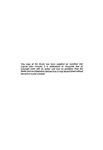Modelling learning behaviour of intelligent agents using UML 2.0
| dc.contributor.supervisor | Denham, M. | |
| dc.contributor.author | Allam, Hossam | |
| dc.contributor.other | Faculty of Science and Engineering | en_US |
| dc.date.accessioned | 2011-05-10T11:27:05Z | |
| dc.date.available | 2011-05-10T11:27:05Z | |
| dc.date.issued | 2005 | |
| dc.identifier | Not available | en_US |
| dc.identifier.uri | http://hdl.handle.net/10026.1/338 | |
| dc.description.abstract |
This thesis aims to explore and demonstrate the ability of the new standard of structural and behavioural components in Unified Modelling Language (UML 2.0 / 2004) to model the learning behaviour of Intelligent Agents. The thesis adopts the research direction that views agent-oriented systems as an extension to object-oriented systems. In view of the fact that UML has been the de facto standard for modelling object-oriented systems, this thesis concentrates on exploring such modelling potential with Intelligent Agent-oriented systems. Intelligent Agents are Agents that have the capability to learn and reach agreement with other Agents or users. The research focuses on modelling the learning behaviour of a single Intelligent Agent, as it is the core of multi-agent systems. During the writing of the thesis, the only work done to use UML 2.0 to model structural components of Agents was from the Foundation for Intelligent Physical Agent (FIPA). The research builds upon, explores, and utilises this work and provides further development to model the structural components of learning behaviour of Intelligent Agents. The research also shows the ability of UML version 2.0 behaviour diagrams, namely activity diagrams and sequence diagrams, to model the learning behaviour of Intelligent Agents that use learning from observation and discovery as well as learning from examples of strategies. The research also evaluates if UML 2.0 state machine diagrams can model specific reinforcement learning algorithms, namely dynamic programming, Monte Carlo, and temporal difference algorithms. The thesis includes user guides of UML 2.0 activity, sequence, and state machine diagrams to allow researchers in agent-oriented systems to use the UML 2.0 diagrams in modelling the learning components of Intelligent Agents. The capacity for learning is a crucial feature of Intelligent Agents. The research identifies different learning components required to model the learning behaviour of Intelligent Agents such as learning goals, learning strategies, and learning feedback methods. In recent years, the Agent-oriented research has been geared towards the agency dimension of Intelligent Agents. Thus, there is a need to conduct more research on the intelligence dimension of Intelligent Agents, such as negotiation and argumentation skills. The research shows that behavioural components of UML 2.0 are capable of modelling the learning behaviour of Intelligent Agents while structural components of UML 2.0 need extension to cover structural requirements of Agents and Intelligent Agents. UML 2.0 has an extension mechanism to fulfil Agents and Intelligent Agents for such requirements. This thesis will lead to increasing interest in the intelligence dimension rather than the agency dimension of Intelligent Agents, and pave the way for objectoriented methodologies to shift more easily to paradigms of Intelligent Agent-oriented systems. | en_US |
| dc.description.sponsorship | The British Council, the University of Plymouth and the Arab-British Chamber Charitable Foundation. | en_US |
| dc.language.iso | en | en_US |
| dc.publisher | University of Plymouth | en_US |
| dc.title | Modelling learning behaviour of intelligent agents using UML 2.0 | en_US |
| dc.type | Thesis | |
| dc.identifier.doi | http://dx.doi.org/10.24382/1571 |
Files in this item
This item appears in the following Collection(s)
-
01 Research Theses Main Collection
Research Theses Main


